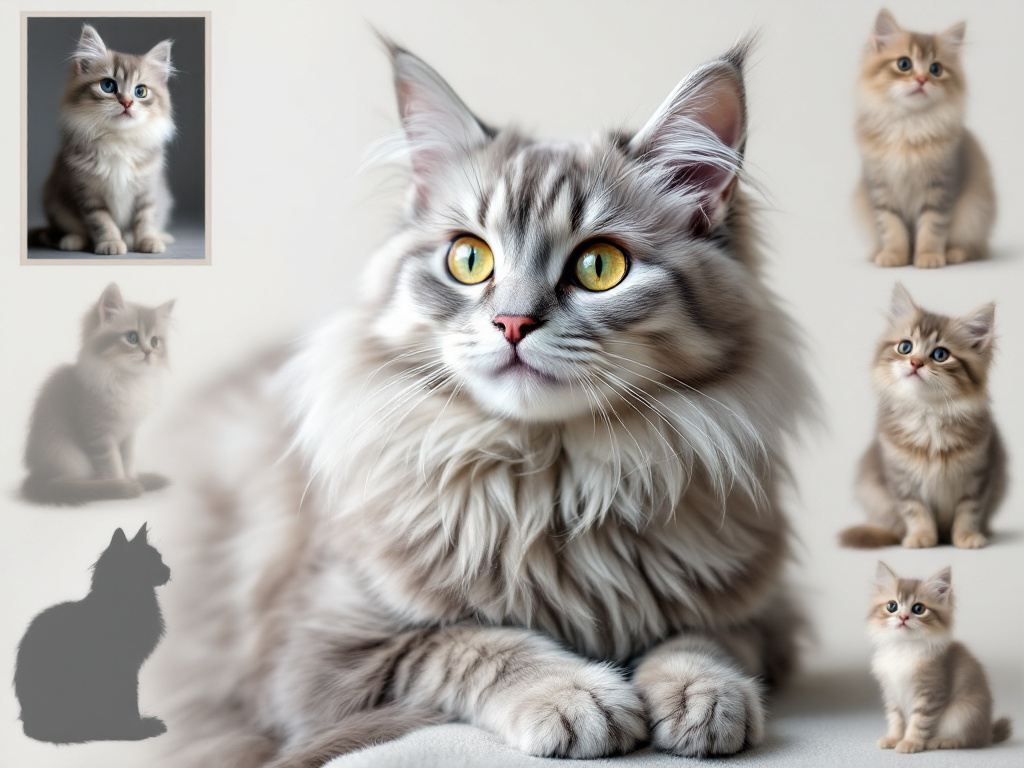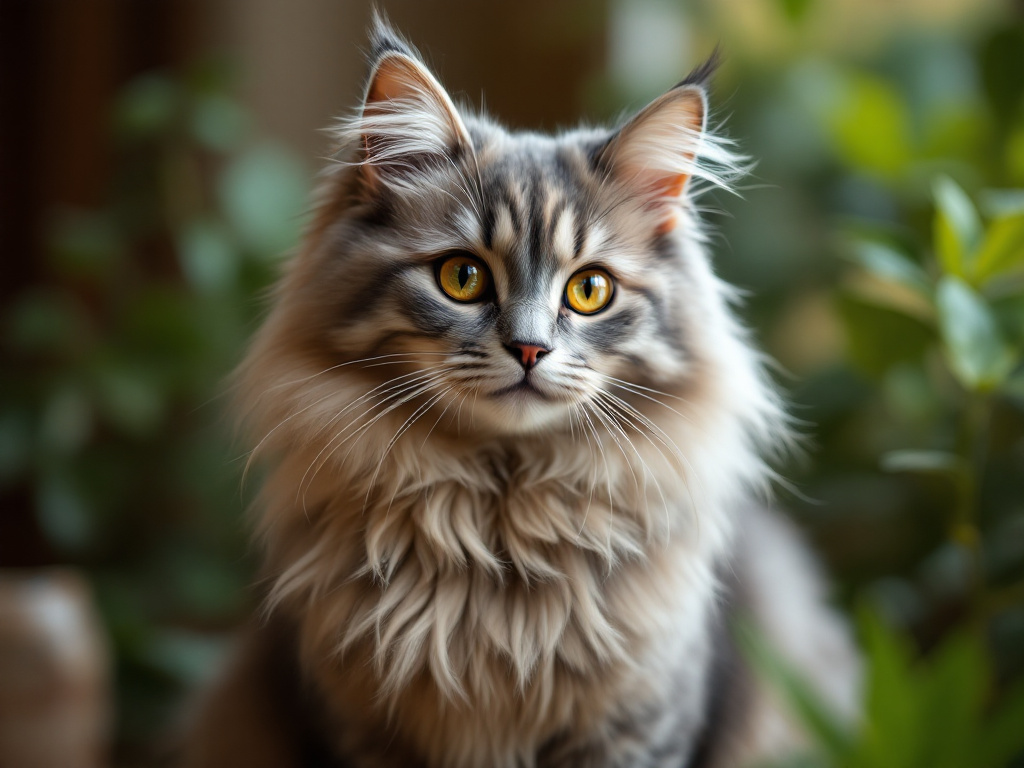
Welcome to our silver Abyssinian photo gallery, where stunning coats and variations dance in every frame. Imagine spotting a cat so shimmering it looks brushed with fine silver dust. That’s exactly what you get with these feline gems.
In the next few scrolls, you’ll explore four main silver types, savour gallery captions, and pick up tips on how to photograph your own silver Abyssinian at home. If you’re new to this breed, start with what a silver Abyssinian cat is, its definition, varieties, and history for a quick primer.
Explore Silver Variations
Before we dive into the snaps, let’s chat about what gives silver Abyssinians that metallic sheen.
Genetics Behind Silver
The magic all starts with genetics. A key inhibitor gene lightens the warm pigment on each hair, leaving a silvery base coat instead. That’s overlaid by the dominant ticked gene (Ta), which creates alternating bands of colour on every hair shaft. This ticked pattern gives the coat its signature shimmer.
Recognised Silver Types
Major cat associations group silver variations separately, even though they’re essentially the same four base colours with a silver-white undercoat. Most breeders recognise usual silver, blue silver, sorrel silver, and fawn silver, though acceptance varies by registry.
Usual Silver
Think of usual silver as the silver counterpart to ruddy Abyssinians.
- Base Coat: silvery white
- Ticking: dark grey to charcoal
- Eye Colour: golden to bronze
Blue Silver
Blue silver sports a cool slate-grey undercoat that’s almost misty in low light.
- Base Coat: pale blue-grey
- Ticking: deeper slate hue
- Eye Colour: greenish gold
Sorrel Silver
Sorrel silver combines a warm cinnamon-grey ticking with a silvery cream base.
- Base Coat: cream with pinkish tint
- Ticking: warm cinnamon-grey
- Eye Colour: rich copper
Fawn Silver
Fawn silver offers a soft beige-silver base with subtle taupe ticking.
- Base Coat: light fawn with silver sheen
- Ticking: grey-brown
- Eye Colour: hazel
Trace Silver Lineage
Curious how silver Abyssinians made their mark in the UK?
Origins Of The Silver Gene
Breeders first spotted the silver mutation in the 1960s, though records are sketchy. Many claim these cats were among the earliest colour variations, but solid proof is hard to come by. What we do know is that the inhibitor gene quietly circulated in small catteries before reaching wider attention.
From First Imports To Today
By the 1980s, silver Abyssinians appeared in early shows, gaining modest popularity. Over the next two decades, TICA and GCCF began recognising these variations in separate classes. For a detailed timeline of imports and milestones, see history of silver abyssinians in the uk from first imports to today.
Compare Silver vs Usual
Wondering how silver Abyssinians stack up against their non-silver counterparts? Here’s a quick side-by-side:
| Feature | Usual Abyssinian | Silver Abyssinian |
|---|---|---|
| Base Coat | Warm ruddy (tawny) | Silvery white |
| Ticking | Ebony to dark brown | Grey to charcoal |
| Eye Colour | Amber to hazel | Golden to bronze |
| CFA Recognition | Yes | No (not accepted) |
| Registry Classification | Standard 4 colours | Separate silver division |
For a deeper dive into colour differences, check the silver vs usual Abyssinian comparison of colours and variants.
Showcase Stunning Coats
Ready to feast your eyes? Below are gallery sections for each silver type—complete with alt text suggestions and caption ideas.
Usual Silver Gallery
Photo 1: A usual silver Abyssinian lounges on a sunlit beam, showing off its soft silver base and bold ticking
- Silvery sheen that dances in morning light
- Dark ticking draws a clear contrast
- Warm golden gaze that holds you
Blue Silver Gallery
Photo 2: This blue silver Abyssinian curls gracefully on a grey cushion, its coat almost blending with the background
- Cool blue-grey undercoat like morning mist
- Subtle slate ticking for depth
- Greenish-gold eyes that pop
Sorrel Silver Gallery
Photo 3: A sorrel silver Abyssinian explores fallen leaves, the cinnamon-grey ticking echoing autumn hues
- Creamy base with warm undertones
- Cinnamon-grey ticking for a coppery vibe
- Bold copper eyes that light up
Fawn Silver Gallery
Photo 4: Reclining on a neutral rug, the fawn silver Abyssinian looks like a living pillow of soft taupe
- Light fawn base with subtle silver sparkle
- Grey-brown ticking that’s elegantly muted
- Hazel eyes that match the ticking
Discover Coat Details
To capture the true beauty of these coats, you need to know where to look.
Ticking Patterns
Each silver Abyssinian hair shaft shows alternating bands of pigment.
- Look near the tips for darker bands that contrast with the silver base
- Check for uniform ticking—uneven bands can signal mixed genealogy
- In bright light, the shimmer becomes almost three-dimensional
Contrast Points
Focus on key areas where silver really sings:
- Ear edges and inner fur
- Paw pads and toe tufts
- Nose leather and whisker pads
Rare Variants
Beyond the main four, you might spot lilac-tinted or experimental silvers (not always show-legal). Breeders sometimes explore new hues, but these never appear in official pedigrees. If you fancy a closer look, see silver Abyssinian rare colour variations, blue sorrel fawn silver.
Showing Standards
If you plan to enter your cat in shows, here’s what to know about UK registries.
UK Registries
- GCCF lists silver as a distinct division
- TICA recognises silver Abyssinians in their silver class
- CFA currently does not accept silver colours
Acceptance In Shows
| Registry | Silver Accepted | Notes |
|---|---|---|
| GCCF | Yes | Separate silver class |
| TICA | Yes | Listed under the silver division |
| CFA | No | Only four classic colours allowed |
More on showing requirements in silver Abyssinians and UK registries gccf tica showing and standards.
Understand Breeding Practices
Keeping those coats pure takes care and ethics.
Ethical Breeding Tips
- Use DNA tests to confirm silver genes (inhibitor gene verification)
- Avoid mixing non-silver kittens back into the silver line
- Screen for common Abyssinian health issues before pairing
Maintaining Silver Lines
- Pair silver offspring together to reinforce the gene pool
- Keep meticulous pedigree records
- Respect registry guidelines for experimental colours
Dive deeper into breeding silver abyssinians genetics ethics and best practices.
Photo Captions & FAQs
Sprinkle these captions on your Instagram posts, then scroll to find quick answers to common queries.
Caption Ideas
- “Silver sheen so real, I nearly polished my lens”
- “Golden eyes meet silver fur—talk about a power combo”
- “When your cat outshines the silver screen”
- “Morning light + silver ticking = magic hour”
- “Proof my cat is part unicorn (silver edition)”
- “Soft as silk, bright as chrome”
- “Feline frost: who needs winter?”
- “Metallic mood in 4 paws”
- “Silver lining? My cat’s entire coat”
- “Just your daily dose of silver splendour”
Frequently Asked Questions
| Question | Answer |
|---|---|
| What is a Silver Abyssinian? | A silver Abyssinian is a variant of the Abyssinian breed with a silver-white base coat and grey or charcoal ticking. |
| How can I tell silver vs usual? | Look for the pale undercoat (silver vs tawny) and cooler-toned ticking (grey vs dark brown). |
| Are they rare? | They’re moderately rare in the UK, though demand is rising—learn more in are silver abyssinians rare availability and demand in the uk. |
| Do silver Abyssinians behave differently? | Temperament matches other Abyssinians—active, curious, and affectionate. Coat colour doesn’t affect personality. |
| Can I show my silver Abyssinian in CFA? | Not at present—CFA only accepts the four classic colours. You can enter GCCF or TICA shows instead. |
| How do I care for their coat? | Regular brushing (once a week) keeps ticking crisp and removes loose fur—see silver abyssinian coat care grooming shedding and maintenance. |
Photograph Your Silver Abyssinian
Want to capture that sheen in your own snaps? Let’s walk through the essentials.
Lighting Techniques
- Use soft natural light (morning or late afternoon) to highlight each hair band
- Avoid direct midday sun, which can overexpose the silver base
- Position your subject near a window with diffused curtains for an even glow
Posing And Patience
- Let your cat settle for a minute before shooting (patience pays off)
- Use toys or treats to catch attention—silver eyes will sparkle on cue
- Keep background colours neutral to avoid clashing with the coat
Equipment Recommendations
- A mid-range DSLR or mirrorless camera with a 50mm lens for a natural perspective
- A reflector or white foam board to bounce light back onto the coat
- A tripod for sharp shots when using lower shutter speeds
Next Steps
You’ve explored shimmering silver variations, learned how to spot unique ticking, and stocked up on caption ideas. Now it’s your turn to snap and share. Which variation dazzles you most—usual silver, blue silver, sorrel silver, or fawn silver? Drop your thoughts below, and if you’re all about keeping that coat in top shape, dive into silver Abyssinian coat care, grooming, shedding, and maintenance.
Happy photographing, and may your feed be forever silver-lined!


